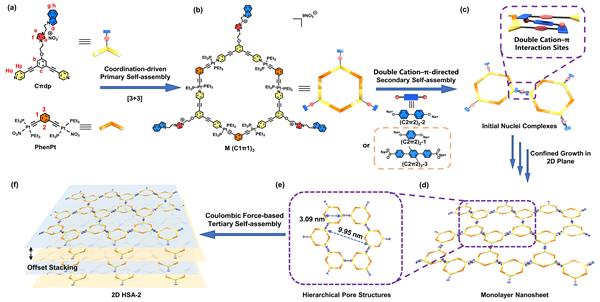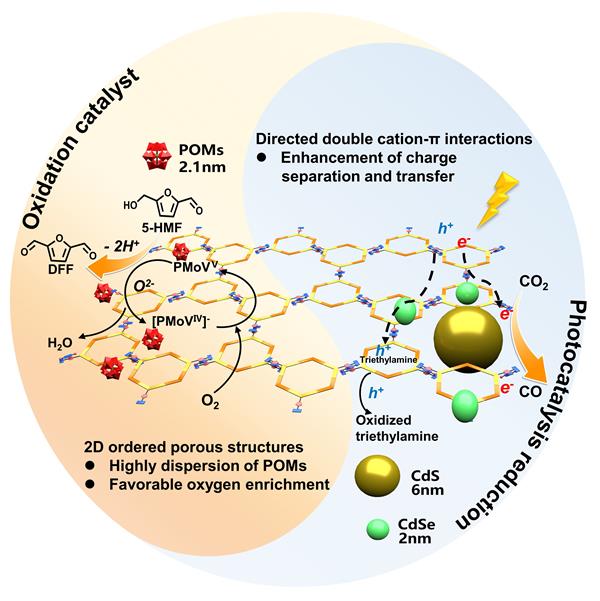The research work conducted by the research group on the construction of two-dimensional metal macrocyclic-based hierarchical assemblies using dual cation-π interactions has been published in JACS
Two-dimensional supramolecular assemblies have garnered widespread attention in the fields of catalysis, sensor devices, and adsorption separation due to their unique planar properties. To meet the increasing complexity and functional demands of these assemblies, constructing functional two-dimensional ordered supramolecular assemblies through hierarchical self-assembly using structurally discrete and well-defined metal macrocycles as building blocks has demonstrated significant research value and application potential. However, the preparation of two-dimensional ordered hierarchical self-assemblies based on metal macrocycles remains a challenge. This is primarily because the orthogonal non-covalent interaction (NCI) forces reported to drive the assembly of metal macrocycles lack sufficient strength and directionality. Additionally, metal macrocycles are often highly rigid, which may hinder adaptive rearrangements to relieve non-planar mismatches between them, thus impeding the sustained growth of large-scale two-dimensional hierarchical structures. The limitations posed by these traditional orthogonal non-covalent interactions and the inherent properties of metal macrocycles make it difficult to control the self-assembly process based on metal macrocycles, severely restricting the expansion of their application areas.
Recently, the research group, building on the earlier work of constructing controllable cation-π chemistry-based supramolecular polymers, has proposed a novel strategy for the supramolecular polymerization of dual cation-π directed metal macrocycles within a two-dimensional plane. This approach has been used to create long-range ordered two-dimensional hierarchical self-assemblies (referred to as CπMNS) with two distinct pore structures. Subsequently, this framework was employed to construct a dual-mode catalytic platform for oxidation catalysis and photocatalysis.
In this study, the authors designed C3-symmetric hexagonal Pt(II) metal macrocycles M(C1π1)3 and a class of C2-symmetric monomers containing benzene rings and two alkali metal cations Na+ (C2π2)2-1/2/3. Taking the assembly of M(C1π1)3 and (C2π2)2-2 as an example, the Pt(II) macrocycle M(C1π1)3 possesses twelve alkyne groups in its framework, which can appropriately reduce the rigidity of the platinum macrocycle, facilitating adaptability in the self-assembly process. Each outer arm of M(C1π1)3 contains indole units (π1) and diethyl imidazolium salt groups (C1), which can selectively engage in specific binding based on dual cation-π interactions with the biphenyl structure (π2) and terminal alkali metal Na+ ions (C2) in the (C2π2)2 monomers. By employing these directional and strong cation-π interactions as the second orthogonal non-covalent interaction (NCI), spatially constrained arrangement of Pt(II) metal macrocycles and assembly growth in three hierarchical levels from the bottom up were achieved, leading to the construction of long-range ordered CπMNS based on metal macrocycles. Finally, the authors applied the constructed CπMNS with two distinct pore structures in the field of catalysis. The results demonstrated that these materials could load and highly disperse two different nano-catalysts for dual-mode catalysis, exhibiting enhanced catalyst stability, selectivity, and catalytic activity.
This work not only showcases a two-dimensional hierarchical assembly based on metal macrocycles, expanding the scope of metal macrocycle-based hierarchical materials, but also develops a new strategy for controlling the two-dimensional self-assembly pathway of metal macrocycles using a dual cation-π directed approach. This provides a novel universal strategy for designing and controlling two-dimensional hierarchical structures based on macrocyclic frameworks.


The research findings were recently published in the "Journal of the American Chemical Society" (2023, doi.org/10.1021/jacs.3c05143).
(Direct link to the paper: https://doi.org/10.1021/jacs.3c05143)
Dr. Wen-Zhuo Chen and Master Zi-Pei Chen are the co-first authors of the paper, with Professor Yingnan Chi from Beijing Institute of Technology as a co-author, and Professor Wei Tian as the corresponding author of the paper.